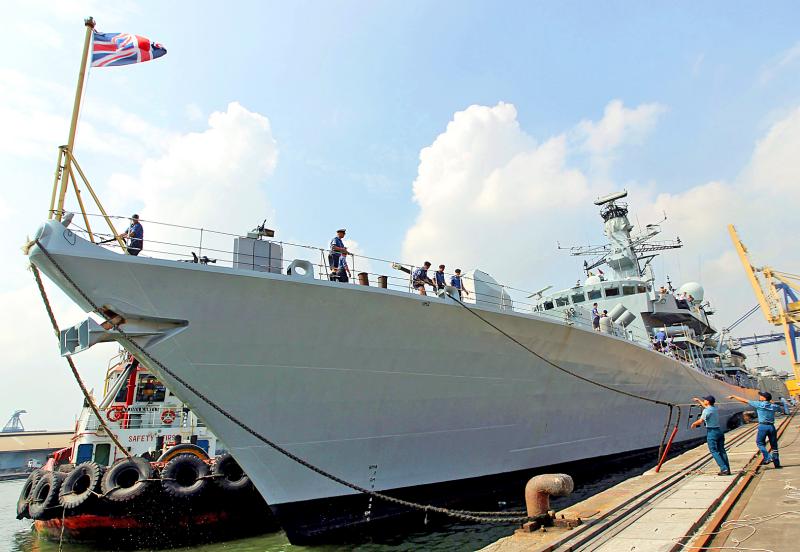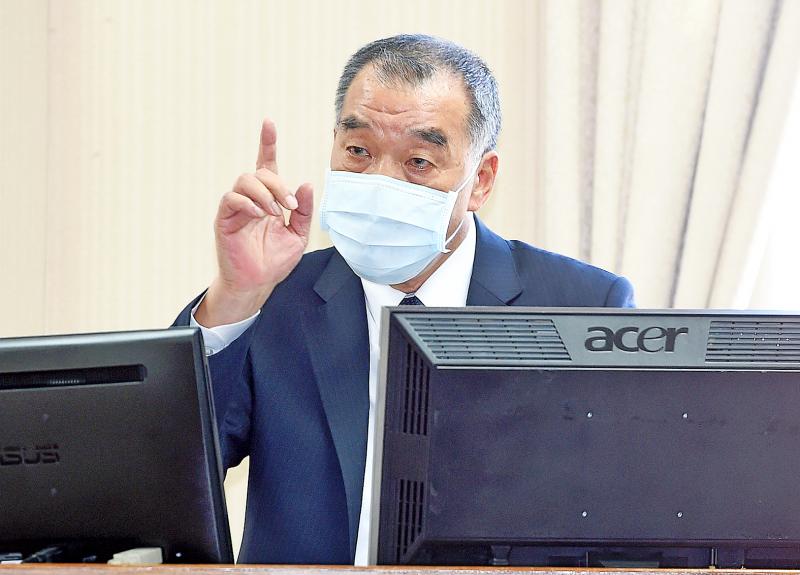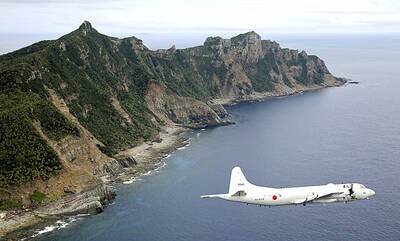British warship the HMS Richmond passed through the Taiwan Strait yesterday morning, according to a social media post from the frigate.
“After a busy period working with partners and allies in the East China Sea, we are now en route through the Taiwan Strait to visit Vietnam and the Vietnam People’s Navy,” the message on Twitter said.
The type 23 Royal Navy frigate is one of the ships deployed with the HMS Queen Elizabeth aircraft carrier and her task group on a global mission to visit more than 40 nations.

Photo: EPA
The aircraft carrier and task group earlier this month made a port call in Yokohama, Japan.
The British embassy in Tokyo said at the time that the deployment was “a powerful demonstration of the UK’s close and enduring partnership with Japan and the UK’s commitment to maritime security in the Indo-Pacific region.”
The passage through the Taiwan Strait came a week after British First Sea Lord Admiral Tony Radakin told Nikkei Asia that the Taiwan Strait is “international waters” and it can be used by any nation, not just by China.

Photo: Liao Chen-huei, Taipei Times
Minister of National Defense Minister Chiu Kuo-cheng (邱國正) said in Taipei that he was not aware of the exact mission of the British warship that was passing through the Taiwan Strait, but that the armed forces have a clear grasp of all foreign vessels operating near Taiwan and would not intervene.
In related news, Chiu yesterday told a meeting of the Foreign Affairs and National Defense Committee at the legislature that Taiwan needs long-range, accurate weapons to properly deter a China that is rapidly developing systems it could use to attack the nation.
The government this month proposed extra defense spending of almost US$9 billion over the next five years, including on new missiles, as it warned of an urgent need to upgrade the nation’s weapons in the face of a “severe threat” from China.
Taiwan needs to let China know that it can defend itself, Chiu said.
“The missiles must be long-range, precise and mobile, so that the enemy can sense that we are prepared as soon as they dispatch their troops,” he said.
In a written report to the legislature, the ministry said that both medium and long-range missiles were being used in intercept drills at a key testing facility on the southeastern coast.
Chiu declined to give details of the range of those missiles.
The ministry gave an unusually stark assessment of China’s abilities in its annual report, saying it could “paralyze” Taiwan’s defenses and is able to fully monitor its deployments.
It is important that Taiwanese are aware of the danger facing them, Chiu said.
Asked what China would attack first in the event of a war, Chiu said that it would be Taiwan’s command and communications abilities.
“On this the Chinese communists’ abilities have rapidly increased. They can disrupt our command, control, communications and intelligence systems, for example with fixed radar stations certainly the first to be attacked,” he said. “So we must be mobile and stealthy.”

MISINFORMATION: The generated content tends to adopt China’s official stance, such as ‘Taiwan is currently governed by the Chinese central government,’ the NSB said Five China-developed artificial intelligence (AI) language models exhibit cybersecurity risks and content biases, an inspection conducted by the National Security Bureau (NSB) showed. The five AI tools are: DeepSeek, Doubao (豆包), Yiyan (文心一言), Tongyi (通義千問) and Yuanbao (騰訊元寶), the bureau said, advising people to remain vigilant to protect personal data privacy and corporate business secrets. The NSB said it, in accordance with the National Intelligence Services Act (國家情報工作法), has reviewed international cybersecurity reports and intelligence, and coordinated with the Ministry of Justice Investigation Bureau and the National Police Agency’s Criminal Investigation Bureau to conduct an inspection of China-made AI language

LIMITS: While China increases military pressure on Taiwan and expands its use of cognitive warfare, it is unwilling to target tech supply chains, the report said US and Taiwan military officials have warned that the Chinese People’s Liberation Army (PLA) could implement a blockade within “a matter of hours” and need only “minimal conversion time” prior to an attack on Taiwan, a report released on Tuesday by the US Senate’s China Economic and Security Review Commission said. “While there is no indication that China is planning an imminent attack, the United States and its allies and partners can no longer assume that a Taiwan contingency is a distant possibility for which they would have ample time to prepare,” it said. The commission made the comments in its annual

‘TROUBLEMAKER’: Most countries believe that it is China — rather than Taiwan — that is undermining regional peace and stability with its coercive tactics, the president said China should restrain itself and refrain from being a troublemaker that sabotages peace and stability in the Indo-Pacific region, President William Lai (賴清德) said yesterday. Lai made the remarks after China Coast Guard vessels sailed into disputed waters off the Senkaku Islands — known as the Diaoyutai Islands (釣魚台) in Taiwan — following a remark Japanese Prime Minister Sanae Takaichi made regarding Taiwan. Takaichi during a parliamentary session on Nov. 7 said that a “Taiwan contingency” involving a Chinese naval blockade could qualify as a “survival-threatening situation” for Japan, and trigger Tokyo’s deployment of its military for defense. Asked about the escalating tensions

DISPUTE: A Chinese official prompted a formal protest from Tokyo by saying that ‘the dirty head that sticks itself out must be cut off,’ after Takaichi’s Taiwan remarks Four armed China Coast Guard vessels yesterday morning sailed through disputed waters controlled by Japan, amid a diplomatic spat following Japanese Prime Minister Sanae Takaichi’s comments on Taiwan. The four ships sailed around the Senkaku Islands — known as the Diaoyutai Islands (釣魚台) to Taiwan, and which Taiwan and China also claim — on Saturday before entering Japanese waters yesterday and left, the Japan Coast Guard said. The China Coast Guard said in a statement that it carried out a “rights enforcement patrol” through the waters and that it was a lawful operation. As of the end of last month,